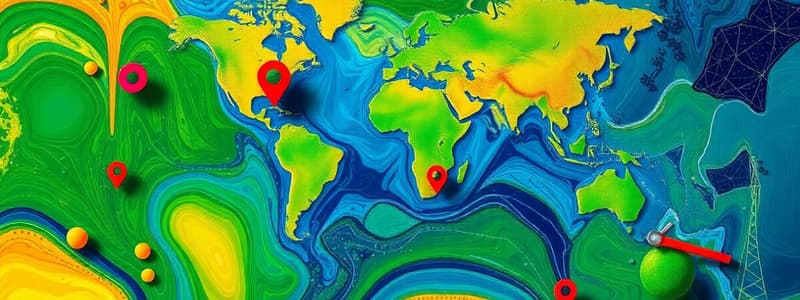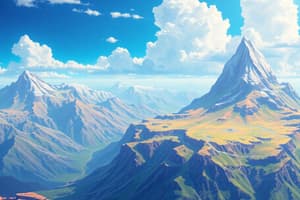Podcast
Questions and Answers
What is the primary focus of physical geography?
What is the primary focus of physical geography?
- Political boundaries and governance
- Economic activities in urban areas
- Cultural aspects of human life
- Natural features and processes (correct)
Which of the following best describes relative location?
Which of the following best describes relative location?
- Exact latitude and longitude coordinates
- Casual perception of a geographic area
- Defined by specific administrative boundaries
- Position of a place in relation to others (correct)
Which method is NOT typically used in geospatial technology?
Which method is NOT typically used in geospatial technology?
- Remote Sensing
- Photojournalism (correct)
- GIS (Geographic Information Systems)
- GPS (Global Positioning Systems)
What type of region is defined by official boundaries such as countries or states?
What type of region is defined by official boundaries such as countries or states?
Which of the following is an example of human-environment interaction?
Which of the following is an example of human-environment interaction?
What are the primary characteristics considered when defining a place?
What are the primary characteristics considered when defining a place?
What does the study of movement in geography primarily involve?
What does the study of movement in geography primarily involve?
Which of the following is NOT a type of map?
Which of the following is NOT a type of map?
What is the primary impact of globalization on geography?
What is the primary impact of globalization on geography?
Which climate zone is characterized by extremely low temperatures and ice?
Which climate zone is characterized by extremely low temperatures and ice?
Flashcards are hidden until you start studying
Study Notes
Key Concepts in Geography
Definition of Geography
- Study of the Earth’s landscapes, environments, and the relationships between people and their environments.
- Branches into physical and human geography.
Branches of Geography
-
Physical Geography
- Focuses on natural features and processes.
- Includes landforms, climate, vegetation, soils, and hydrology.
-
Human Geography
- Examines human activities and their spatial variations.
- Involves cultural, economic, political, and social aspects.
-
Geospatial Technology
- Use of tools like GIS (Geographic Information Systems), GPS (Global Positioning Systems), and remote sensing.
- Important for data collection and spatial analysis.
Important Concepts
Location
- Absolute Location: Exact coordinates (latitude and longitude).
- Relative Location: Position in relation to other places.
Place
- The characteristics that make a location unique.
- Includes physical attributes (landforms, climate) and human elements (culture, architecture).
Region
- An area defined by certain unifying characteristics.
- Types of regions:
- Formal: Defined by official boundaries (countries, states).
- Functional: Defined by a function (urban area influenced by a city).
- Vernacular: Perceived regions based on cultural identity (the South in the USA).
Movement
- The mobility of people, goods, and ideas across the planet.
- Examines how transportation and communication affect geography.
Human-Environment Interaction
- Explores how humans adapt to and modify the environment.
- Includes topics like urbanization, resource use, and sustainability.
Geographical Tools and Techniques
- Maps: Representations of geographic areas; types include topographic, thematic, and political maps.
- GIS: Software for mapping and analyzing spatial data.
- Remote Sensing: Gathering data from satellites or aircraft to study Earth's surface.
Global Issues in Geography
- Climate Change: Impact on weather patterns, sea levels, and ecosystems.
- Urbanization: Growth of cities and its effects on society and the environment.
- Globalization: Interconnectedness of economies, cultures, and populations.
Physical Features of the Earth
- Landforms: Mountains, valleys, plains, plateaus, and deserts.
- Water Bodies: Oceans, rivers, lakes, and glaciers.
- Climate Zones: Tropical, temperate, polar, and arid climates.
Cultural Geography
- Study of cultural practices, languages, religions, and demographics.
- Examines how culture influences spatial organization and interactions.
Population Geography
- Distribution, density, and trends in human populations.
- Important concepts include migration, urbanization, and demographic transition.
Economic Geography
- Analysis of economic activities and spatial distribution.
- Focus on industries, agriculture, trade, and resource management.
Definition of Geography
- Study of the Earth’s landscapes and environments, including human-environment relationships.
- Divided into two main branches: physical geography and human geography.
Branches of Geography
- Physical Geography
- Analyzes natural features like landforms, climate, vegetation, soils, and hydrology.
- Human Geography
- Investigates human activities and their variations across space, including cultural, economic, political, and social dimensions.
- Geospatial Technology
- Utilizes tools such as Geographic Information Systems (GIS), Global Positioning Systems (GPS), and remote sensing for data collection and spatial analysis.
Important Concepts
Location
- Absolute Location
- Defined by exact coordinates, expressed in latitude and longitude.
- Relative Location
- Describes a place in relation to other locations.
Place
- Unique characteristics of a location which include physical attributes (landforms, climate) and human elements (culture, infrastructure).
Region
- Defined areas with unifying characteristics including:
- Formal Regions: Officially demarcated boundaries (e.g., countries, states).
- Functional Regions: Defined by a particular function (e.g., urban areas influenced by cities).
- Vernacular Regions: Based on cultural identities or perceptions (e.g., the American South).
Movement
- Examines the mobility of people, goods, and ideas, highlighting the impact of transportation and communication on geographic dynamics.
Human-Environment Interaction
- Explores how people adapt to and modify their environment, including urbanization, resource use, and strategies for sustainability.
Geographical Tools and Techniques
- Maps
- Various types include topographic, thematic, and political maps, crucial for geographic representation.
- GIS
- Software used for mapping and analyzing spatial data, essential for modern geography.
- Remote Sensing
- Involves collecting data from satellites or aircraft to analyze and study the Earth’s surface.
Global Issues in Geography
- Climate Change
- Affects weather patterns, sea level rise, and ecosystem stability.
- Urbanization
- The expansion of cities and its socio-environmental impacts.
- Globalization
- Highlights the interconnectedness of economies, cultures, and populations around the world.
Physical Features of the Earth
- Landforms include mountains, valleys, plains, plateaus, and deserts.
- Water Bodies consist of oceans, rivers, lakes, and glaciers.
- Climate Zones categorize the Earth's climates into tropical, temperate, polar, and arid.
Cultural Geography
- Investigates cultural practices, languages, religions, and demographics, focusing on how culture shapes spatial organization and interactions.
Population Geography
- Studies the distribution, density, and trends of human populations, including migration patterns, urbanization processes, and demographic transitions.
Economic Geography
- Analyzes economic activities and their spatial distribution, with emphasis on industries, agriculture, trade, and resource management.
Studying That Suits You
Use AI to generate personalized quizzes and flashcards to suit your learning preferences.




